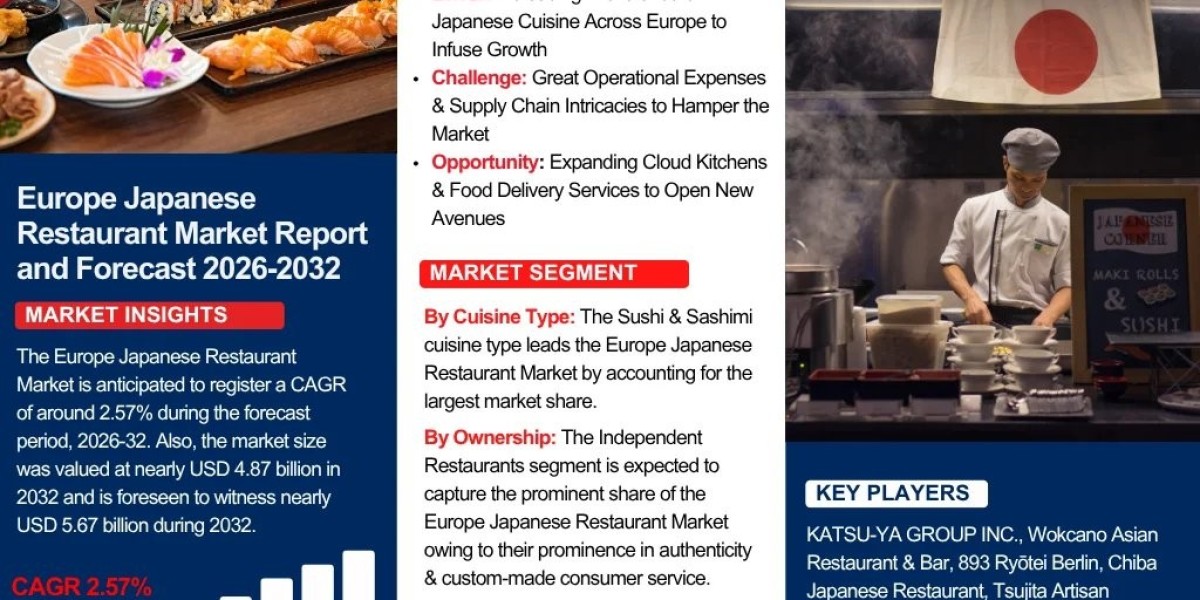Market Overview and Financial Projections
The European Japanese restaurant market is positioned for steady expansion, with analysts projecting a compound annual growth rate (CAGR) of 2.57% from 2026 to 2032. Current market valuation stands at USD 4.87 billion in 2025, with forecasts indicating growth to USD 5.67 billion by 2032. This upward trajectory reflects the increasing European appetite for authentic Japanese culinary experiences and the broader cultural integration of Japanese cuisine across major metropolitan areas.
The United Kingdom emerges as the fastest-growing market segment, driven by London's diverse culinary landscape and the nation's openness to international food trends. Key market players include established names such as KATSU-YA GROUP INC., Wokcano Asian Restaurant & Bar, and innovative establishments like 893 Ryōtei Berlin, each contributing to the market's dynamic competitive environment.
Cultural Drivers and Consumer Preferences
Japanese cuisine's rising popularity stems from multiple converging factors. European consumers increasingly associate Japanese food with health-conscious dining, attracted by the cuisine's emphasis on fresh ingredients, balanced nutrition, and aesthetic presentation. The cultural influence of Japanese entertainment, particularly anime and tourism experiences, has created a generation of consumers familiar with and eager to explore authentic Japanese dining.
The market encompasses diverse offerings ranging from traditional sushi and sashimi to contemporary interpretations of ramen, tempura, and bento boxes. Service models have evolved to include traditional dine-in experiences, quick-service formats, and expanding delivery options, reflecting changing consumer preferences and lifestyle demands.
Millennials and urban populations particularly drive demand, seeking dining experiences that combine nutritional value with cultural authenticity. This demographic's willingness to experiment with international cuisines, coupled with their health and wellness focus, positions Japanese restaurants favorably within Europe's competitive dining landscape.
Market Dynamics and Growth Challenges
Primary Growth Driver: Cultural Integration and Health Consciousness
The fundamental driver powering market expansion is Japanese cuisine's successful integration into European food culture. Social media platforms, cooking shows, and food blogs have amplified awareness and appreciation for Japanese culinary techniques and ingredients. The visual appeal of Japanese dining experiences, particularly omakase and izakaya formats, resonates strongly with European consumers seeking Instagram-worthy dining moments.
Health-conscious consumers view Japanese cuisine as an ideal balance of flavor and nutrition. Sushi and sashimi, perceived as low-calorie yet nutrient-dense options, align perfectly with contemporary wellness trends. This positioning differentiates Japanese restaurants from other international cuisine segments competing for European market share.
Operational Challenges: Cost and Supply Chain Complexity
Market growth faces significant headwinds from operational complexities inherent to maintaining authentic Japanese dining experiences. Import costs for traditional ingredients including nori, miso, wasabi, and specialized fish varieties create substantial overhead expenses. These ingredients require sophisticated cold-chain logistics and face regulatory compliance requirements that add operational complexity.
Labor costs present another challenge, as authentic Japanese restaurants require skilled sushi chefs and trained culinary professionals familiar with traditional preparation techniques. The shortage of qualified personnel in European markets drives up wage expenses and limits expansion capabilities for many operators.
Capital requirements for authentic interior design, specialized kitchen equipment, and maintaining the aesthetic elements crucial to Japanese dining experiences create additional barriers, particularly for smaller operators seeking market entry.
Emerging Opportunities and Market Innovations
Cloud Kitchen Revolution
The emergence of delivery-focused cloud kitchens presents transformative opportunities for market expansion. These models significantly reduce overhead costs while enabling restaurants to reach broader geographic markets without traditional brick-and-mortar investments. Urban centers including London, Madrid, and Milan have witnessed growing success of cloud kitchen operations specializing in Japanese cuisine delivery.
Strategic partnerships with third-party delivery platforms have democratized access to high-quality Japanese cuisine, allowing consumers to experience authentic flavors from their homes. This model particularly appeals to younger demographics comfortable with app-based ordering and provides established restaurants with low-risk market expansion opportunities.
Fusion Innovation and Experiential Dining
Contemporary market trends favor fusion approaches that blend traditional Japanese techniques with European ingredients and flavor profiles. Restaurants like Wokcano and Florilège demonstrate successful adaptation strategies that honor Japanese culinary integrity while appealing to local taste preferences.
Interactive dining experiences, including teppanyaki performances, robotic sushi preparation, and zen-inspired interior design, capture the attention of experience-seeking consumers. Generation Z and millennial diners particularly value these immersive elements, viewing dining as entertainment rather than simple sustenance.
Geographic Market Leadership and Future Outlook
The United Kingdom maintains its position as the dominant European market for Japanese cuisine, benefiting from cultural diversity, robust tourism infrastructure, and consumer willingness to embrace international food trends. London's concentration of Japanese restaurants, ranging from accessible sushi bars to Michelin-starred establishments, exemplifies the market's maturity and growth potential.
Germany, France, Italy, and Spain represent significant expansion opportunities, with each market demonstrating unique characteristics and consumer preferences that successful operators must navigate. The increasing frequency of Japanese cultural festivals and pop-up dining events across these markets indicates growing consumer interest and market readiness.
The forecast period through 2032 suggests continued steady growth, supported by demographic trends favoring international cuisine, health-conscious dining choices, and the ongoing cultural influence of Japanese entertainment and lifestyle trends across European markets.







